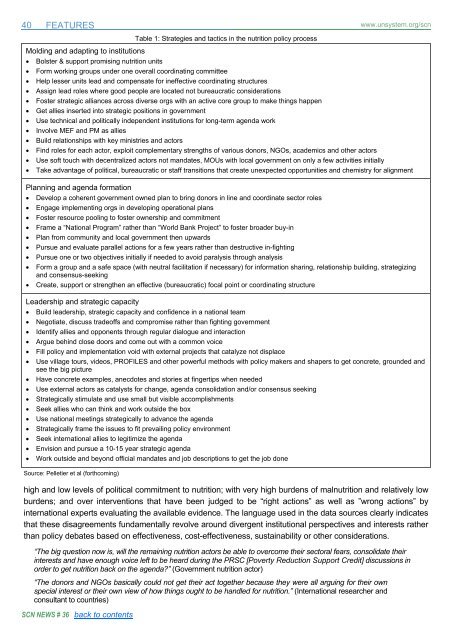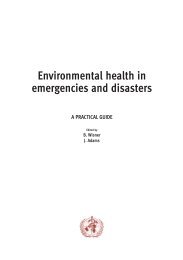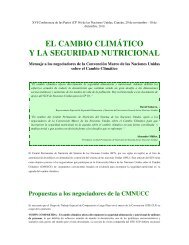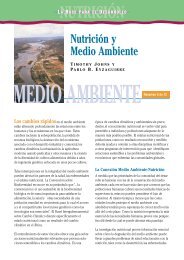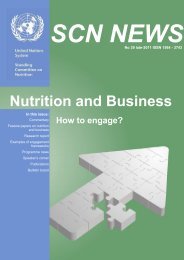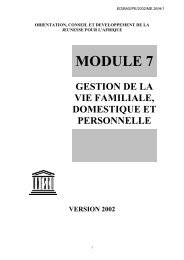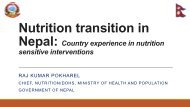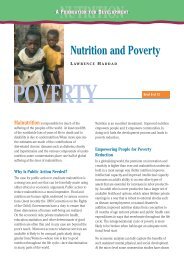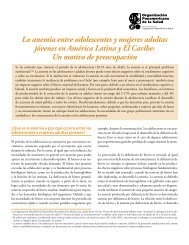SCN News No 36 - UNSCN
SCN News No 36 - UNSCN
SCN News No 36 - UNSCN
You also want an ePaper? Increase the reach of your titles
YUMPU automatically turns print PDFs into web optimized ePapers that Google loves.
40<br />
FEATURES<br />
Molding and adapting to institutions<br />
• Bolster & support promising nutrition units<br />
• Form working groups under one overall coordinating committee<br />
• Help lesser units lead and compensate for ineffective coordinating structures<br />
• Assign lead roles where good people are located not bureaucratic considerations<br />
• Foster strategic alliances across diverse orgs with an active core group to make things happen<br />
• Get allies inserted into strategic positions in government<br />
• Use technical and politically independent institutions for long-term agenda work<br />
• Involve MEF and PM as allies<br />
• Build relationships with key ministries and actors<br />
• Find roles for each actor, exploit complementary strengths of various donors, NGOs, academics and other actors<br />
• Use soft touch with decentralized actors not mandates, MOUs with local government on only a few activities initially<br />
• Take advantage of political, bureaucratic or staff transitions that create unexpected opportunities and chemistry for alignment<br />
Planning and agenda formation<br />
• Develop a coherent government owned plan to bring donors in line and coordinate sector roles<br />
• Engage implementing orgs in developing operational plans<br />
• Foster resource pooling to foster ownership and commitment<br />
• Frame a “National Program” rather than “World Bank Project” to foster broader buy-in<br />
• Plan from community and local government then upwards<br />
• Pursue and evaluate parallel actions for a few years rather than destructive in-fighting<br />
• Pursue one or two objectives initially if needed to avoid paralysis through analysis<br />
• Form a group and a safe space (with neutral facilitation if necessary) for information sharing, relationship building, strategizing<br />
and consensus-seeking<br />
• Create, support or strengthen an effective (bureaucratic) focal point or coordinating structure<br />
Leadership and strategic capacity<br />
• Build leadership, strategic capacity and confidence in a national team<br />
• Negotiate, discuss tradeoffs and compromise rather than fighting government<br />
• Identify allies and opponents through regular dialogue and interaction<br />
• Argue behind close doors and come out with a common voice<br />
• Fill policy and implementation void with external projects that catalyze not displace<br />
• Use village tours, videos, PROFILES and other powerful methods with policy makers and shapers to get concrete, grounded and<br />
see the big picture<br />
• Have concrete examples, anecdotes and stories at fingertips when needed<br />
• Use external actors as catalysts for change, agenda consolidation and/or consensus seeking<br />
• Strategically stimulate and use small but visible accomplishments<br />
• Seek allies who can think and work outside the box<br />
• Use national meetings strategically to advance the agenda<br />
• Strategically frame the issues to fit prevailing policy environment<br />
• Seek international allies to legitimize the agenda<br />
• Envision and pursue a 10-15 year strategic agenda<br />
• Work outside and beyond official mandates and job descriptions to get the job done<br />
Source: Pelletier et al (forthcoming)<br />
high and low levels of political commitment to nutrition; with very high burdens of malnutrition and relatively low<br />
burdens; and over interventions that have been judged to be “right actions” as well as ”wrong actions” by<br />
international experts evaluating the available evidence. The language used in the data sources clearly indicates<br />
that these disagreements fundamentally revolve around divergent institutional perspectives and interests rather<br />
than policy debates based on effectiveness, cost-effectiveness, sustainability or other considerations.<br />
“The big question now is, will the remaining nutrition actors be able to overcome their sectoral fears, consolidate their<br />
interests and have enough voice left to be heard during the PRSC [Poverty Reduction Support Credit] discussions in<br />
order to get nutrition back on the agenda?” (Government nutrition actor)<br />
“The donors and NGOs basically could not get their act together because they were all arguing for their own<br />
special interest or their own view of how things ought to be handled for nutrition.” (International researcher and<br />
consultant to countries)<br />
<strong>SCN</strong> NEWS # <strong>36</strong> back to contents<br />
Table 1: Strategies and tactics in the nutrition policy process<br />
www.unsystem.org/scn


